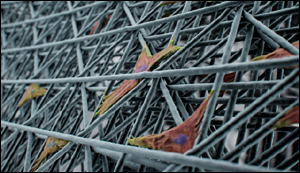New 3-D printing approach makes cell-scale lattice structures
27. 3. 2019 | MIT | www.mit.edu
A new way of making scaffolding for biological cultures could make it possible to grow cells that are highly uniform in shape and size, and potentially with certain functions. The new approach uses an extremely fine-scale form of 3-D printing, using an electric field to draw fibers one-tenth the width of a human hair.
Many functions of a cell can be influenced by its microenvironment, so a scaffold that allows precise control over that environment may open new possibilities for culturing cells with particular characteristics, for research or eventually even medical use.

While ordinary 3-D printing produces filaments as fine as 150 microns (millionths of a meter), researchers say, it’s possible to get fibers down to widths of 10 microns by adding a strong electric field between the nozzle extruding the fiber and the stage on which the structure is being printed. The technique is called melt electrowriting.
Read more at MIT
Image Credit: Eli Gershenfeld
-jk-




